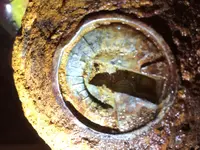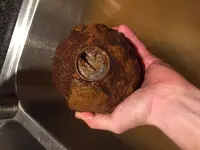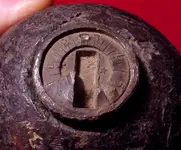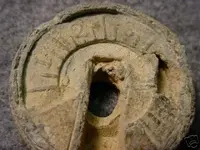It appears to have a yankee-made Bormann fuze in it, not CS-made. The first line next to the pie-slice shaped wedge stands for 1/2-second on the CS version, and for 3/4-second on the US version. The photos below show what I'm talking about. On the CS fuze there are two raised lines counterclockwise from the number 1. On the US fuze, there is only one raised line counterclockwise from the number 1.
"As dug" (rust-encrusted, and not deactivated), your US Bormann-fuzed 12-Pounder caliber shell is worth about $125, because nobody can tell for sure whether the condition of the iron under the rust-encrustation is above-average or average or poor. Also, it has not been Inerted (hasn't had its powder-charge removed).
I must emphasize, your EXCAVATED cannonball is NOT dangerous to handle, or even to drop on a concrete floor.
The proof: Excavated cannonballs have been dropped, been in car-wrecks, and nearly every one of them got hit hard with a shovel during the digging-up process. There has not been even a single report of a cannonball blowing up during the digging process, or from being dropped. The few that have exploded did so when somebody put the ball into a very hot fire or was drilling into it. If you can avoid doing either of those two "extremely provocative" things to a cannonball, the only way it'll hurt you is if you drop it on your foot. I speak as a US Goverment certified expert on this subject. I've taught classes on civil war artillery projectiles to police bomb squads and US Army EOD teams. The US National Park Service has used me to empty several civil war shells found by park rangers at the battlefield parks here in Virginia. Speaking of which... Mercer87nc, send me a Private Message if you want to get your civil war cannonball professionally "Inerted" (emptied).





 all jokes aside, keep it in water outside your house somewhere safe until you can get it drilled by someone who knows what they are doing.
all jokes aside, keep it in water outside your house somewhere safe until you can get it drilled by someone who knows what they are doing.

